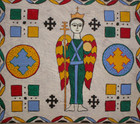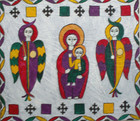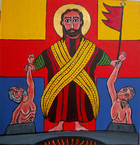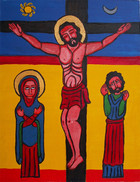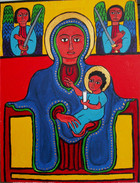Among the Copts
Although the Egyptian Coptic Church is one of the oldest branches of Christianity, I knew very little about this North African faith community, except for some vague notion that the Copts had split from Byzantium very early on in an arcane dispute over the nature(s) of Christ. Then, I discovered Coptic art on a journey to the ancient Monastery of St. Paul in a mountain valley near the Red Sea, some 100 miles southeast of Cairo, and my eyes were opened.
The domes and walls of the ancient chapel cave of this 4th century Desert Father were covered in some of the most astonishing frescoes of horsemen, saints and angels I had ever seen. The faces were so perfectly round they looked drawn with a compass. The eyes were huge and almond-shaped, meeting at the narrowest bridge of a nose. The hands, like those of stick figures. Any section of these wall-paintings could have been chiseled out and hung with pride in a modern art gallery. Most amazing of all, the holy images appeared to be smiling!
The Ethiopian Orthodox Church was considered part of the Coptic communion until 1955, and Ethiopian religious paintings also convey a sense of holiness far different from the Byzantine iconography with which I was familiar from my years of living in Russia. Like the sacred art of Coptic Egypt, the figures in Ethiopian icons are far less elongated and austere than Byzantine prototypes and the palette of colors seems to explode off the panel.
During a Holy Week trip to Jerusalem in 2003, I experienced the spontaneity of Ethiopian Orthodox worship, when I joined the local community for the Great Easter Vigil on their rooftop enclave at the Church of the Holy Sepulcher. Caught up in the exuberant mood of the dancing crowd, as priests in ornate vestments and miters passed by me under huge ceremonial umbrellas, I sensed the joy of the Resurrection in a special way.
I wanted to know the Egyptians and Ethiopians better by imitating their sacred art, but trying to capture the simple forms and bright colors of the Copts proved far more difficult than I expected. My knowledge of the tricks artists play to create depth and perspective kept getting in the way of a purer, simpler vision of the sacred. The Egyptian-styled paintings were made on plaster, smeared on wooden panels, to give the appearance of frescoed walls.

